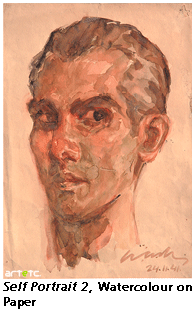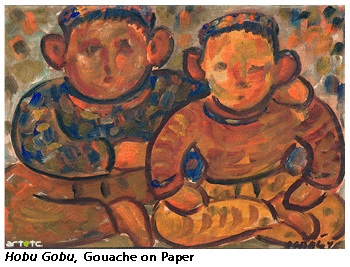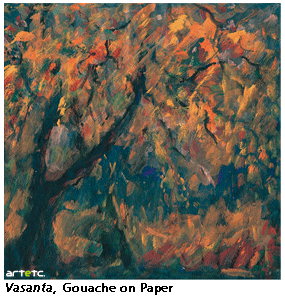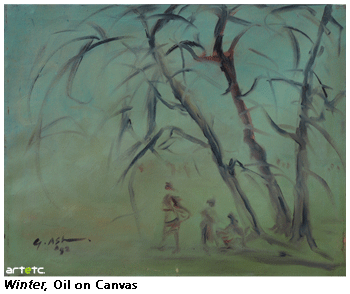- Publisher's Note
- Editorial
- Looking from the Other Side
- Women in Rabindranath Tagore's Paintings
- Ramkinkar Baij's Santhal Family
- The Birth of Freedom in Moments of Confinement
- Jamini Roy's Art in Retrospect
- The Great Journey of Shapes: Collages of Nandalal Bose
- Haripura Posters by Nandalal Bose: The Context and the Content
- The Post-1960s Scenario in the Art of Bengal
- Art Practice in and Around Kolkata
- Social Concern and Protest
- The Dangers of Deifications
- Gobardhan Ash: The Committed Artist of 1940-s
- Gopal Ghose
- Painting of Dharmanarayan Dasgupta: Social Critique through Fantasy and Satire
- Asit Mondal: Eloquence of Lines
- The Experiential and Aesthetic Works of Samindranath Majumdar
- Luke Jerram: Investigating the Acoustics of Architecture
- Miho Museum: A Structure Embedded in the Landscape
- Antique Victorian Silver
- Up to 78 Million American Dollars1 !
- Random Strokes
- Are We Looking At the Rise of Bengal
- Art Basel and the Questions it Threw Up
- What Happened and What's Forthcoming
- Art Events Kolkata, May – June 2012
- Mumbai Art Sighting
- Delhi Dias
- Art Bengaluru
- Preview June, 2012 – July, 2012
- In the News, June 2012
ART news & views
Gobardhan Ash: The Committed Artist of 1940-s
Issue No: 30 Month: 7 Year: 2012
by Mrinal Ghosh
 Gobardhan Ash was one of the pioneering artists who had considerable contributions in devising the modernistic forms of the Indian painting during the decade of 1940-s. He had deep commitment both towards the socio-temporal reality and towards his own life and creativity. He struggled a lot during his formative years against his personal poverty and also against lack of creative infrastructure within the artistic environment of that time. He was rebellious both as an artist and art activist. All these characteristics devised his personality and the forms of his art.
Gobardhan Ash was one of the pioneering artists who had considerable contributions in devising the modernistic forms of the Indian painting during the decade of 1940-s. He had deep commitment both towards the socio-temporal reality and towards his own life and creativity. He struggled a lot during his formative years against his personal poverty and also against lack of creative infrastructure within the artistic environment of that time. He was rebellious both as an artist and art activist. All these characteristics devised his personality and the forms of his art.
When Ash arrived at his own creativity during the middle of 1930-s, the art situation of Bengal was within a dilemma. There was struggle between the two modes of modernity. One was British academic naturalist trend originated after 1850-s through the works of the Art School trained artists. The other was neo-Indian school originated by Abanindranath Tagore during 1897 and expanded by his disciples like Nandalal Basu and others towards various modes of expressions, which was considered to be a prototype of national identity. By 1930-s both of these modes showed the signs of stagnations and degeneration. The poet Rabindranath Tagore first detected these limitations and tried to find ways and means of regeneration. In 1919 he established Kala-Bhavana at Santiniketan where he tried to broaden the aesthetic outlook of the artists. Two artists, however, within the environment of neo-Indian school were working to expand the field of form. They were Gaganendranath Tagore and Sunayani Devi. Rabindranath himself approached towards visual creativity since 1923-24 and appeared as a very original and intuitive painter since 1928. Out of his dissatisfaction with the extant trends, Jamini Roy also paved a new way taking the cue from the popular art of Bengal since early 1930-s.

This was the art environmental situation in Bengal when Gobardhan Ash appeared in the field. Like other artists of his generation he had his dissatisfaction which induced him to find a new way. He had considerable skill in academic naturalism. But he could feel that form to be anachronistic to express the social reality of his time. He could not accept the revivalist trends of neo-Indian school. He noticed the achievements of Jamini Roy to generate forms from the folk. Personally he also had a rural background and adequate knowledge of popular expressions. He tried to induce it within his won constructions. He also felt, one aspect was lacking in the existing modes of modernity. Western modernistic forms generated out of impressionism, post-impressionism, expressionism and cubism had not been adequately explored, which, he could feel, was necessary to express the social turmoil and humanistic decay that darkened the life of Bengal during 1940-s. In building up his own form he made this synthesis through assimilation of naturalism, folk and western modernistic distortions.


The social situation in India and particularly in Bengal during the decade of 1940-s was very tumultuous. The freedom struggle rose to its peak along with the colonial exploitation. The famine of 1943 was the highest expression of the callousness and inhumanity of the alien rulers. Ash made his art a vehicle to express his rebellion against such inhuman decays. Like Jainul Abedin, Chittaprasad and Somnath Hore he was also an important artist of 1940-s, who made artistic documentation of the famine of Bengal, painted extensively on this theme and generated a form out of this decay that made considerable imprint on his further development. He looked towards beauty from these roots of dilapidation. His forms were thus an amalgamation of the beauty and the void.
 Gobardhan Ash was born on 5 August, 1907 at the village of Begampur in Hoogly district of West Bengal. His father was Haricharan Ash and mother Gouri Devi. He spent all his life in this village and died here in 1996 at the matured age of 89. He was admitted to the Government School of Art, Calcutta in 1926. Percy Brown was the Principal at that time. He was not happy with the system of education there and left the school after four years. In 1932 he went to Madras and joined as a student at Government Art School there and learnt under Devi Prasad Roychowdhury, who was the Principal. There also he did not felt happy and returned back to Calcutta after a year without completing the course. As an art activist he had an inclination towards artistic group activities. In 1931 he formed the group 'Young Artists Union' in Calcutta. Other members of the group were Abani Sen, Kalikinkar Ghosh Dastidar, Renu Roy and others. These young artists in 1933 formed the group 'Art Rebel Centre'. Gobardhan Ash was its first secretary.
Gobardhan Ash was born on 5 August, 1907 at the village of Begampur in Hoogly district of West Bengal. His father was Haricharan Ash and mother Gouri Devi. He spent all his life in this village and died here in 1996 at the matured age of 89. He was admitted to the Government School of Art, Calcutta in 1926. Percy Brown was the Principal at that time. He was not happy with the system of education there and left the school after four years. In 1932 he went to Madras and joined as a student at Government Art School there and learnt under Devi Prasad Roychowdhury, who was the Principal. There also he did not felt happy and returned back to Calcutta after a year without completing the course. As an art activist he had an inclination towards artistic group activities. In 1931 he formed the group 'Young Artists Union' in Calcutta. Other members of the group were Abani Sen, Kalikinkar Ghosh Dastidar, Renu Roy and others. These young artists in 1933 formed the group 'Art Rebel Centre'. Gobardhan Ash was its first secretary.
'Calcutta Group' was formed in 1943 in the year of Bengal famine under the leadership of Prodosh Dasgupta. The other important members of the group were Paritosh Sen, Gopal Ghosh, Nirod Majumder, Rathin Moitra, Shubho Thakur and some others. At the invitation of Dasgupta Gobardhan Ash joined the group in 1949. Calcutta Group had considerable contribution towards development of forms of modernity of the 1940-s through assimilation of Western modern and Indian folk that considerably reflected the social reality of that time. This they did before Progressive Artists Group of Bombay formed in 1947 entered in the field. Calcutta Group in this way has a pioneering role. Gobardhan Ash, as member of the group, made considerable contribution in this direction.
His life was full of struggle. He started his professional career by joining as 'Supervisor Artist' in Central Ordnance Depot, Agra in 1944. Before and after that he struggled with many professions, both personal and institutional. In 1953 he joined as teacher in Indian School of Art, Calcutta. He had financial constraints through out his life. But that could not deter him from his artistic integrity. Painting for him was a kind of spiritual meditation. Through out his life he experimented with various forms, scaled from one peak to the other and left behind him enormous number of paintings that were both documentation of the flowing life and reality, also reflection through form the cultural wisdom of humanity.